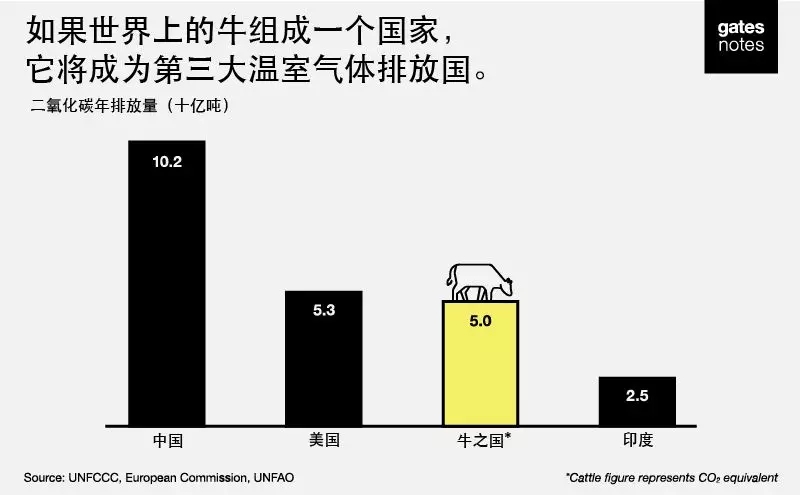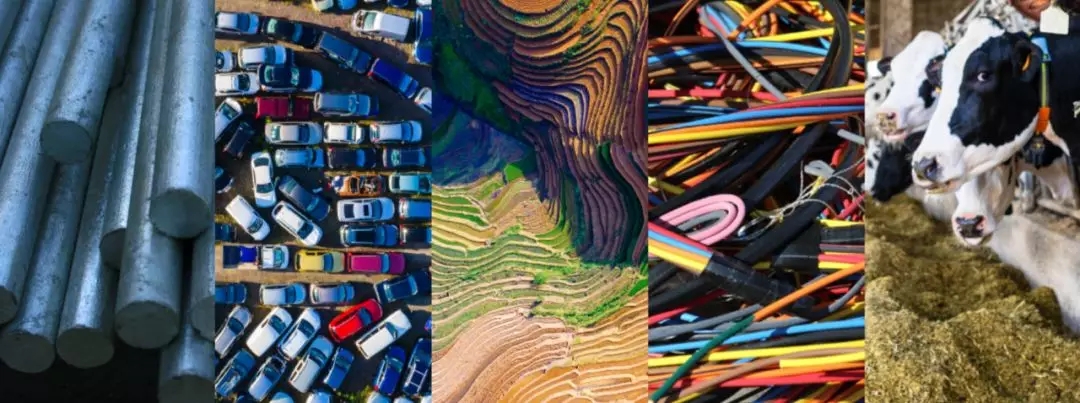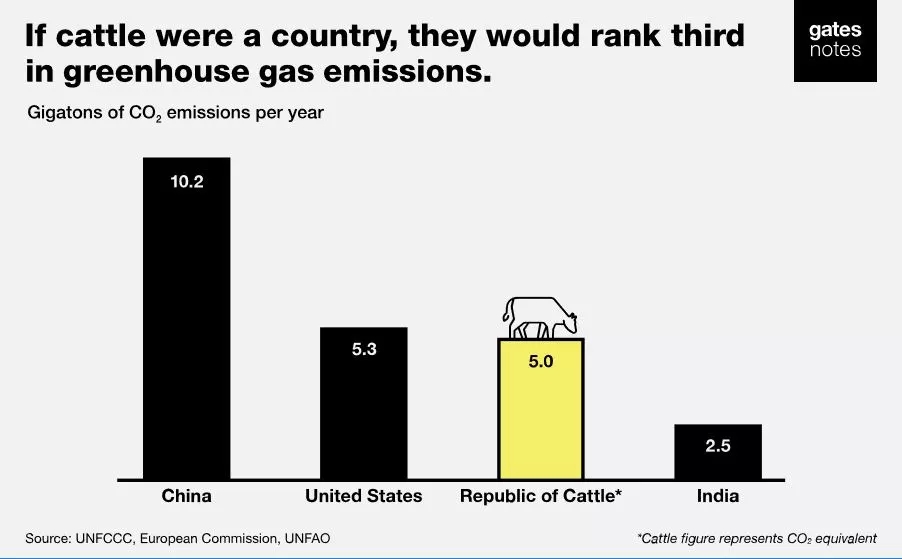比尔·盖茨(Bill Gates)的官方微信公众号(gatesnotes)在2018年10月19日发布了本文。他的公众号经常会分享他见过的人、读过的书和学到的功课,内容包括全球健康、能源创新、教育改革和读书笔记等。

快问快答:想一想有助于应对气候变化的发明。
你的第一反应是什么?我打赌你想到了太阳能电池板和风力涡轮。根据我的经验,这是人们在思考降低温室气体排放时马上会提出来的。
这没有错。可再生能源正变得越来越便宜,许多国家承诺更多地依靠它们而非化石燃料来满足电力需求。这是个好消息,至少对于那些阳光或风力充足的地方。每个关心气候变化的人都应该希望我们继续对发电方式进行去碳化。
我希望这足以解决问题。可惜,事实并非如此。
发电所产生的温室气体仅占全部温室气体排放量的25%。因此,即使我们完全采用绿色发电,不排放一个温室气体分子(实现这一点也还有很长的路要走),我们也只能将总排放量减少四分之一。
为了防止气候变化带来的最恶劣影响,我们需要在50年内使每个经济领域的温室气体净排放量都达到零——而联合国政府间气候变化专门委员会(IPCC)刚刚发现,我们必须在接下来10年就走上这条路。这意味着既要处理电力问题,又要处理另外那75%的问题。
温室气体的排放源自哪里?我想把它分为五大类——我称之为“阻止气候变化的五大挑战”:
电力(25%)。尽管可再生能源市场取得了进展,我们仍需要更多突破。例如,我们需要有除风能和太阳能之外备用的零排放能源,应对无风、长时间多云和夜晚的情况。我们还要使电网更高效,以便在需要的时间向需要的地方提供清洁能源。
农业(24%)。牛是甲烷的巨大来源。事实上,如果世界上的牛组成一个国家,将成为第三大温室气体排放国!此外的一个问题就是森林砍伐——例如腾出土地用于耕种——把能吸收空气中二氧化碳的树木砍掉了。当树木被焚烧时,它们又把所有的碳释放回大气中了。

制造业(21%)。看看你周围的塑料、钢铁和水泥。所有这些共同作用,导致了气候变化。制造水泥和钢铁需要大量来自化石燃料的能量,在这过程中的化学反应会释放含碳的副产品。因此,即使我们可以用零排放能源制造出所有我们需要的东西,我们仍然需要处理副产品。
交通运输(14%)。低排放汽车很棒,但今天汽车只占交通相关碳排放量的一半不到,而且这一比例在未来还会继续降低。更多的排放来自飞机、货船和卡车。目前对于这些交通工具,我们没有任何实际的零排放选择。
建筑物(6%)。你在有空调的地方生活或工作吗?空调内的制冷剂就是一种温室气体。此外,运行空调、加热器、灯和其他电器需要耗费大量的能源。更高效的窗户和绝缘材料一类的东西会对此有所帮助。随着全球人口迁移到城市,这一领域在未来几十年将变得更加重要。到2060年,世界的建筑数量将增加一倍。打个比方,这等于是说在接下来的40年里,每个月将新诞生一个纽约市。
(第六个类别占剩下的那10%,即其他杂项,包括提取石油和天然气所需的能源等。)
我认为列出这些大挑战有助于我们思考气候变化。它们说明了能源不仅让你的房子和汽车正常运转,而且它几乎是生活每个部分的核心——食物、衣服、房子和你使用的产品。为了阻止地球继续变暖,我们需要在产品制造、粮食种植、人员交通和货物运输等方面取得突破,而不是只考虑如何为家庭和汽车供电。
这些挑战正变得越来越紧迫。全球的中产阶级正以前所未有的速度增长,随着收入增长,你的碳足迹也会增加。你可以买一辆自行车(它虽不使用汽油,但很可能是用能源密集型金属制成的,通过燃烧化石燃料的货船和卡车送到你手中),用来替代步行。最后你买了一辆摩托车,这样你就可以到离家更远的地方做一份更好的工作,从而付得起孩子的学费。你的家人能吃上更多的鸡蛋、肉和奶制品,这样他们就能获得更好的营养。你在市场购买冰箱和电灯,这样你的孩子可以在晚上学习,同时你也将自己置身于一个由金属和混凝土构成的坚固房屋之中。
所有这些新型消费切实改善了人们的生活。它对整个世界都有好处,但对气候来说非常糟糕,除非我们找到既能满足消费,又不向大气中排放更多温室气体的办法。
这无疑是一个棘手问题。取得重大突破的前景仍不明朗。我们很可能需要针对每项挑战提供多种解决方案。这就是为什么我们现在需要加大对全部五个领域的投资和研发。
幸运的是,政府和私营部门正在加紧努力。自2015年推出“创新使命“ (Mission Innovation)以来,已有二十多个政府承诺将清洁能源的研发支出增加一倍——可用资金额每年增加30多亿美元。
就我个人而言,我是“突破能源联盟” (Breakthrough Energy Ventures(BEV))投资者当中的一员,该基金投资超过10亿美元,帮助有前途的公司将实验室的好想法投放到市场上进行推广。我们正在使用上面提到的五大挑战作为我们的投资框架。我们支持的每一个想法都旨在解决其中一个问题,而我们与欧洲建立的新合作将给这项使命提供更大的动力。
我们仍在细化方案,但今天我能告诉你的是:本周我将在布鲁塞尔签署突破能源联盟与欧盟委员会的协议。我们的目标是创建一个名为“欧洲突破能源”(Breakthrough Energy Europe)的联合投资项目,帮助那些致力于应对这些巨大挑战的欧洲公司。合作者将承诺总计1亿欧元的资金,其中一半来自欧盟委员会,另一半来自突破能源联盟。
但这不仅仅是钱的问题。我们正在创造一种让这些钱奏效的新渠道。
由于能源研究需要数年(甚至数十年)才能有所收获,公司需要投资者有耐心,愿意与他们长期合作。从理论上讲,政府可以提供这种投资,但在实际操作中,政府并不擅长鉴别有前途的公司,以及以灵活的方式帮助这些公司发展。
这就是这项合作伙伴关系的亮点所在。它允许投资于前沿研究开发的欧盟委员会与懂得建设公司的投资者合作。由于该基金将由私人管理,它可以避免一些拖泥带水或从中做梗的官僚做派。这将给予我们用来创造有意义改变的资源,以及可以快速行动的灵活性。这是个不寻常的组合。
我希望这次合作只是一个开始。我们需要全世界有更多像这样的伙伴关系。
在接下来的一年里,关于这五大挑战中的每一个,我都将撰写一系列博文,重点关注我正在了解的一些有前景的解决方案。我受到的启发来自于应对气候变化的优秀发明家和所有支持他们的合作伙伴。我迫不及待地想与你分享他们的成果。

Climate change and the 75% problem
Quick: Think of some inventions that help fight climate change.
What came to mind first? I bet you thought of solar panels and wind turbines. In my experience, that’s what people point to when they think about reducing greenhouse gas emissions.
They’re not wrong. Renewables are getting cheaper and many countries are committing to rely more on them and less on fossil fuels for their electricity needs. That’s good news, at least in places that get a lot of sunlight or wind. Everyone who cares about climate change should hope we continue to de-carbonize the way we generate electricity.
I wish that were enough to solve the problem. Unfortunately, it isn’t.
Making electricity is responsible for only 25% of all greenhouse gas emissions each year. So even if we could generate all the electricity we need without emitting a single molecule of greenhouse gases (which we’re a long way from doing), we would cut total emissions by just a quarter.
To prevent the worst effects of climate change, we need to get to zero net greenhouse gas emissions in every sector of the economy within 50 years—and as the IPCC recently found, we need to be on a path to doing it in the next 10 years. That means dealing with electricity, and the other 75% too.
Where do greenhouse gas emissions come from? I like to break it down into five main categories—what I call the grand challenges in stopping climate change:
Electricity (25%). Although there’s been progress in the renewable energy market, we still need more breakthroughs. For example, wind and solar need zero-carbon backup sources for windless days, long periods of cloudy weather, and nighttime. We also need to make the electric grid a lot more efficient so clean energy can be delivered where it’s needed, when it’s needed.
Agriculture (24%). Cattle are a huge source of methane; in fact, if they were a country, they would be the third-largest emitter of greenhouse gases! In addition, deforestation—clearing land for crops, for instance—removes trees that pull CO2 out of the air, and when the trees are burned, they release all their carbon back into the atmosphere.

Manufacturing (21%). Look at the plastic, steel, and cement around you. All of it contributed to climate change. Making cement and steel requires lots of energy from fossil fuels, and it involves chemical reactions that release carbon as a byproduct. So even if we could make all the stuff we need with zero-carbon energy, we’d still need to deal with the byproducts.
Transportation (14%). Low-emission cars are great, but cars account for a little less than half of transportation-related emissions today—and that share will shrink in the future. More emissions come from airplanes, cargo ships, and trucks. Right now we don’t have practical zero-carbon options for any of these.
Buildings (6%). Do you live or work in a place with air conditioning? The refrigerant inside your AC unit is a greenhouse gas. In addition, it takes a lot of energy to run air conditioners, heaters, lights, and other appliances. Things like more-efficient windows and insulation would help. This area will be more important over the next few decades as the global population moves to cities. The world’s building stock will double in area by 2060. That’s like adding another New York City every month for 40 years.
(The final 10% is a sixth, miscellaneous category that includes things like the energy it takes to extract oil and gas.)
I think these grand challenges are a helpful way to think about climate change. They show how energy isn’t just what runs your house and your car. It’s core to nearly every part of your life: the food you eat, the clothes you wear, the home you live in, the products you use. To stop the planet from getting substantially warmer, we need breakthroughs in how we make things, grow food, and move people and goods—not just how we power our homes and cars.
These challenges are only getting more urgent. The world’s middle class has been growing at an unprecedented rate, and as you move up the income ladder, your carbon footprint expands. Instead of walking everywhere, you can afford a bicycle (which doesn’t use gas but is likely made with energy-intensive metal and gets to you via cargo ships and trucks that run on fossil fuels). Eventually you get a motorbike so you can travel farther from home to work a better job and afford to send your kids to school. Your family eats more eggs, meat, and dairy, so they get better nutrition. You’re in the market for a refrigerator, electric lights so your kids can study at night, and a sturdy home built with metal and concrete.
All of that new consumption translates into tangible improvements in people’s lives. It is good for the world overall—but it will be very bad for the climate, unless we find ways to do it without adding more greenhouse gases to the atmosphere.
This is undoubtedly a tough problem. It is not obvious what the big breakthroughs will look like. Most likely we will need several solutions to each challenge. That is whywe need to invest in lots of research and development, across all five areas, now.
Fortunately, governments and the private sector are stepping up. Since the 2015 launch of Mission Innovation—two dozen governments that committed to doubling their spending on clean-energy R&D—the amount of funding available has gone up by more than $3 billion a year.
Personally, I’m part of a group of investors in a private fund called Breakthrough Energy Ventures (BEV), which is putting more than $1 billion into helping promising companies take great ideas from the lab to market at scale. We’re using the five grand challenges I mentioned above as the framework for our investments. Every idea we’re supporting is designed to solve one of them—and our mission is about to get a big boost from a new partnership in Europe.
We’re still working out the details, but here’s what I can tell you today: I’ll be in Brussels this week to sign an agreement between Breakthrough Energy and the European Commission. Our goal is to create a joint investment vehicle called Breakthrough Energy Europe, which will serve as a pilot fund investing in European companies working on the grand challenges. The partners will commit €100 million, half from the European Commission and half from BEV.
But this isn’t only about funding. We’re creating a new way of putting that money to work.
Because energy research can take years—even decades—to come to fruition, companies need patient investors who are willing to work with them over the long term. Governments could in theory provide that kind of investing, but in reality, they aren’t great at identifying promising companies and staying nimble to help those companies grow.
That’s where this partnership can shine. It allows the European Commission, which is funding cutting-edge research and development, to partner with investors who know how to build companies well. Because the fund will be privately managed, it can avoid some of the bureaucracy that slows things down and makes it hard to support new companies. We’ll have the resources to make a meaningful difference, and the flexibility to move quickly. That’s a rare combination.
I hope this partnership is just the beginning. We need many more like this one around the world.
Over the next year, I will be writing a series of TGN posts about each of the five challenges, focusing on some of the promising solutions I’m learning about. I’m inspired by the ingenious inventors who are tackling climate change and all the partners who are supporting their work. I can’t wait to share their progress with you.